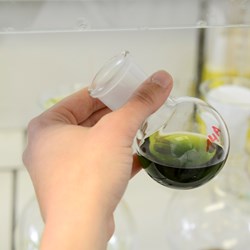


Research by Food & Lipids, KU Leuven Campus Kulak Kortrijk, has shown that microalgae are naturally less sensitive to oxygen than fish oil. "This makes microalgae a suitable source of the long-chain omega-3 fatty acids EPA and DHA for food enrichment," explains Prof. Dr Imogen Foubert.

© KU Leuven
Long-chain omega-3 fatty acids EPA and DHA have several health benefits. They reduce the risk of cardiovascular disorders and are necessary for brain development in foetuses and young children, concludes Professor Imogen Foubert of Food & Lipids, KU Leuven Campus Kulak Kortrijk, listing some of the benefits. "Unfortunately, most consumers do not get enough of these fatty acids through their diet." Our bodies barely produce these fatty acids at all, so the health benefits are not achieved. The recommended daily intake (RDI) is somewhere between 140 and 600 milligrams per day, depending on the country and health organisation consulted.

© KU Leuven
The easiest way
The easiest way to get enough EPA and DHA is to eat more fatty fish, but fish stocks are too small to supply everyone. Because omega-3 fatty acids in fish oil are very sensitive to oxygen due to their chemical structure (double bonds), hardly any food products are enriched with them. So it was necessary to look for alternative sources that are suitable for enriching food products.

© KU Leuven
Microalgae as a source
Autotrophic microalgae, grown using CO2 and sunlight, quickly came into the picture, continues Foubert. "Fatty fish only contain EPA and DHA because they consume microalgae, which are the first step in the marine food chain." An important advantage of these microalgae, compared with fish oil and heterotrophic microalgae grown using an organic carbon source such as glucose, is the presence of endogenous antioxidants: carotenoids, polyphenols, phytosterols and certain vitamins. This was shown in the doctoral research conducted by Eline Ryckebosch of Food & Lipids. Stability was also closely examined. "It has been shown that carotenoids in particular prevent oxidation," Foubert explains. The big downside of these microalgae is now the cost price. The technology for cultivating and processing the biomass is still under development. The professor expects microalgae with omega-3 fatty acids to reach the market within a few years.

“It is always advisable to maintain a critical perspective on your own products and adjust them to contemporary needs where necessary”, emphasises Marijke Adriaens, CEO of frozen food company Fribona. “For consumers, taste is still the main consideration. It is essential to work towards a product that is, above all, tasty and visually appealing.”...

Scientists from KU Leuven have discovered how oil penetrates snacks during and after the frying process. Recent research findings point to advanced frying techniques that reduce oil absorption, as well as innovative methods to limit oil uptake during the cooling phase. This paves the way for the development of healthier snacks without compromising...

Food companies are increasingly targeting a wider range of consumer groups. Speaking at an event organised by Fenavian, Julian Mellentin of New Nutrition Business said this strategy offers significant opportunities to respond to the diverse health needs and interests of today’s consumers. “Consumers enjoy both animal and plant-based proteins”, he...

Backed by financial partners, Start it @KBC is launching the accelerator programme Scale it Agro, aimed at scale-ups offering sustainable and innovative agricultural solutions for agriculture and horticulture businesses. Kjell Clarysse, programme director at Scale it Agro, goes into more detail.